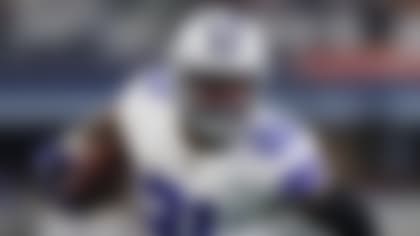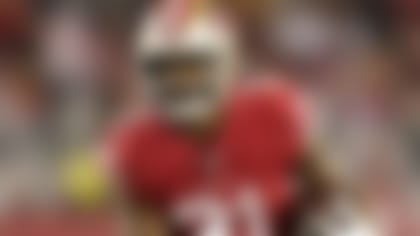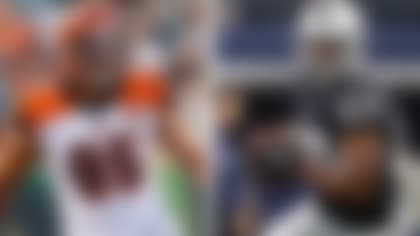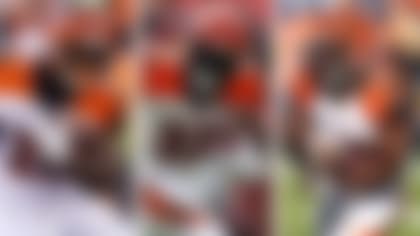The winds of fantasy are changing. No longer do running backs or much less quarterbacks own the top spots on draft boards. These days it's the wide receiver position that dominates the desires of fantasy owners. As Rich Hribar demonstrated recently, the trend of drafting wide receiver-heavy teams is not a fad with the league's shift to emphasizing the passing game and the talent at the wide receiver position.
In order to better understand the position, I created the methodology called Reception Perception to measure every aspect of wide receivers. The system takes an eight-game sample (with a mix of unproductive and productive games) and creates unique metrics you cannot find anywhere else. Reception Perception quantifies route-running with success rate metrics across every route against man, zone, press, and double coverage to measure how often a player gets open. There are also ancillary metrics like contested catch conversion rate and "in space" tackle-breaking measurements.
Reception Perception, when married with other factors, can help identify breakouts before they happen, as it did with Allen Robinson or veterans who can bounce back such asMichael Crabtree.
Armed with the knowledge gleaned from the methodology, while accounting for opportunity and situation, we can identify the receivers who are most deserving of our attention in fantasy drafts. Here are 11 receivers that are "must-owns" in 2016. Oh, and we'll spare some of the more obvious players. You don't need me to tell you why Antonio Brown is a top-pick.
1. The elite WR1 it all lines up for
A.J. Green, Bengals - Antonio Brown, Odell Beckham, and Julio Jones are consistently ranked as the top three wide receivers across the industry this year. All three deserve the clout they currently own. However, there's a fourth wide receiver who could creep into that tier with the Big Three.
The public at large knows A.J. Green is a fantasy WR1. Green is the only other receiver outside of Randy Moss to have at least 1,000 yards in each of his first five NFL seasons. Yet, he was a bit more frustrating in 2015 than in years prior. Green was a weekly WR1 five times, but a WR3 or worse 10 times. In six out of those 10 weeks, he scored in the single-digits for standard leagues.
While those numbers don't conjure up fond memories, let's make sure to cast no blame toward the Pro Bowl wide receiver. Green's 2015 Reception Perception sample showed he was as good as ever in his fifth NFL season. He posted a 71.8 percent success rate versus man coverage and a 77.8 percent versus press. Both figures place him within the top-10 for 2015. He also came down with 88.9 percent of his contested catch attempts, which is the second highest conversion rate in the series' history.
The reason behind Green's inconsistent 2015 campaign was a lack of reliable volume. The Bengals offense was stacked with playmakers last year. In addition to Green, Cincinnati fielded a star tight end in Tyler Eifert, a strong No. 2 in Marvin Jones, a gadget threat in Mohamed Sanu and a pass-catcher out of the backfield in Giovani Bernard. All the while, they tried to establish a power-running game with Jeremy Hill. That's a stocked cupboard of playmakers, and while Andy Dalton took great strides in his fifth NFL season, he's not at the level of a 2013 Peyton Manning where he can make all tides rise in an offense.
Having to share the load with so many other playmakers saw Green finish with his lowest market share of the team's offense since his rookie season.
In 2016, the tides should shift back to Green in a major way. The Bengals failed to adequately replace Jones or Sanu, who both left for bigger opportunities elsewhere. Brandon LaFell starting in place of Jones is a downgrade and rookie Tyler Boyd (a painfully limited player) is pegged as their slot receiver "no matter what." It would be something of an upset if both players combine for the 30 percent share of the team targets Jones and Sanu garnered in 2015. Additionally, Tyler Eifert -- the likely No. 2 target -- isn't the picture of health, funneling more of the offense to Green.
A.J. Green should once again get back to the 30 percent market share, 160-plus target range. When he accomplished that feat in 2012 and 2013, he finished as a top-four receiver in fantasy. The stars are aligning for Green to return to the level of elite scoring receivers in 2016, and it feels painfully familiar to the way Julio Jones jumped into that group last year.
As a small bonus in Green's corner, Reception Perception quantified that Green was a great deep route-runner last year. Rather surprisingly, he ran a go-route on 28.4 percent of his sampled routes and posted a 58.2 percent success rate. Both of those figures are well above the charted NFL average. Andy Dalton finished 11th among NFL starters in average depth per aimed throw in 2015, per Pro Football Focus. More big plays should be in store for Green once he secures a higher share of the targets.
Without question, A.J. Green should be the consensus fourth wide receiver off the board once you get past the trappings of just looking at what happened last season. He's a total steal if he slips to Round 2.
The 2016 DeAndre Hopkins
Keenan Allen, Chargers - DeAndre Hopkins didn't really sneak up on anyone last year, as he was widely a third-round pick and the WR14 across fantasy formats last year. However, he still crushed that price finishing as the WR4 in PPR leagues. Hopkins is a phenomenal talent, but negative game script, enormous play volume, and target share helped boost his 2015 breakout season.
On the surface, Hopkins' fellow 2013 draft pick Keenan Allen is destined to walk down a nearly identical path in 2016. In reality, Allen was on his way to that season already last season before he went down in Week 8 with a freak kidney injury. Prior to going on IR, Allen was on pace for over 1,400 yards with a 26 percent share of the pass-heavy Chargers' targets. It was a legitimate breakthrough campaign for the third-year receiver, who bounced back from a middling sophomore year following a 1,000 yard rookie year.
Keenan Allen's Reception Perception was nothing short of extraordinary. His 77.1 success rate versus man coverage was the third-best score in the methodology's history, trailing only 2014 Odell Beckham and Antonio Brown's marks. While plenty of analysts offer doubts regarding Allen's status as a true No. 1 receiver, his success rate of 79.6 percent against 98 press attempts and 82.6 contested catch conversion rate dismiss those questions.
Allen's route distribution makes him not only a tremendous asset for the Chargers but also a reliable entity for his fantasy owners. Of the 298 routes charted for his Reception Perception sample, 58.4 percent were slants, curls, and posts. These in-breaking routes are perfect for Philip Rivers' skill set and Allen's ability to flash open quickly on them makes him an appealing target. Allen's success rates on these routes are within the top five for each pattern, and the Chargers just thumped teams with that up-tempo quick passing early in the season.
We see that Allen is a proficient and probably underrated receiver, but he also has the other factors in his favor necessary for a top fantasy season. The Chargers will end up being a passing team, whether they want to or not. Based on 2015, we can only believe they'll establish an offensive foundation on Melvin Gordon's rushing ability when we see it. They added some fine pieces to their defense in Casey Heyward and No. 3 overall pick Joey Bosa, but they'll need more than that to drastically improve Football Outsiders' DVOA 25th ranked defense. The Chargers ranked first in plays per drive last season and have little reason to scale back their tempo.
The combination of voluminous offense and negative game script is fantasy gold. Marry that with a receiver Reception Perception regards among the league's best and you're closing in on a nirvana-like state of scoring.
Much like Hopkins, Keenan Allen isn't sneaking up on anybody. The best you can hope for is netting him in the early third-round, but he's more likely a second-rounder regardless of format. The only reason he's not a consensus top-12 pick is the injury cloud hanging over. If he stays healthy, all the factors involved in this equation will boost the uber-talented Allen into the top-six, at worst, among fantasy receivers in 2016.
The all too obvious breakout candidate
Donte Moncrief, Colts - You may have long forgotten by now, but Donte Moncrief already broke out last year. Even with Andrew Luck and the entire offense playing below previous standards, Moncrief made his presence felt early. In the first seven weeks of the regular season, he produced at a rate that had him on pace to finish with 77 catches, 870 yards and 11 touchdowns by year's end. He was a monster in the red zone in those seven games, catching four scores inside the 20-yard line, and turning three of four targets inside the 10-yard line into touchdowns.
After that, Moncrief and the Colts ran into the NFL's best two defenses from last year in Carolina and Denver, and then Andrew Luck went down for the season. The Colts offense spiraled downward after that as Matt Hasselbeck, Charlie Whitehurst, Ryan Lindley and Josh Freeman took turns at quarterback. Moncrief's once-torrid pace fell off the rails, and he finished with just 733 yards and six touchdowns.
When you divorce Moncrief from his moribund surroundings, through the lens of Reception Perception, it becomes clear he was anything but the cause of his own statistical slowdown. Moncrief's athletic prowess is impressive, but the way that his route-running improved from college to his rookie year to becoming a true strength in 2015 is what makes him especially intriguing.
Moncrief dialed back his deep route rate from an eye-popping 35.6 percent ratio in 2014 to just 18.3 as a sophomore. His success rates on digs (81.3) and comebacks (76.2), two of the more difficult routes to run, jumped up to match with some of the NFL's best receivers. He also improved his success rate versus press coverage from a league average score to a strong 70.9 percent.
Fresh off a massive contract extension and healthy headed into training camp, Andrew Luck should help redirect the Colts back to their status as a top-10 scoring offense. Moncrief has far less talent around him to compete with like he did in his first two seasons. Gone are Andre Johnson, Coby Fleener and the 161 targets they took with them. The receiver depth chart behind still-learning 2015 first-rounder Phillip Dorsett is near barren.
After being a spread-out passing unit for much of the last three seasons, the Colts could emerge as a coveted two-receiver concentrated offense for fantasy owners in 2015 with Moncrief and T.Y. Hilton competing for the top spot. Moncrief should walk right into a 20 percent market share as the No. 2 target, at worst. He'll easily exceed his mid-round ADP in casual drafts and is a league-winning type of pick for 2016.
Don't you forget about me
John Brown, Cardinals - For some reason, John Brown falls anywhere between the fifth and eighth-round in fantasy drafts, depending on the format. He's currently the WR33 in Fantasy Football Calculator's ADP and the third Arizona Cardinals receiver off the board. That's far too steep a discount for such an ascendant young talent who could finish as the top receiver on his own offensive juggernaut of a team.
John Brown caught Reception Perception's eye early when he finished well above expectations as a rookie. Outside of Odell Beckham, Brown was the only other 2014 rookie to score above the NFL average success rate vs. coverage in all four categories (man, press, zone, and double). His score against man coverage was the second best amongst charted rookies. Back then he was mostly just a deep threat, but showed great potential as a route-runner to someday graduate to a much higher status.
In 2015, he delivered on the optimism, posting a success rate vs. coverage score over the NFL average on every route besides the flat and "other" in his Reception Perception sample. While this helped show he is more than just a deep threat, we also must not forget Brown is still one of the NFL's top downfield receivers:
Brown is a diminutive receiver but plays well above his size. His 63.6 contested catch conversion rate is strong considering his 180-pound frame, while his 74.6 percent success rate versus press coverage illustrates that he's one of the best receivers at getting off jams. Not only is he one of the most fun players to watch in the NFL, he's a precise, detailed and nuanced craftsmen.
Fantasy owners have a false impression of Brown that he's a boom or bust option. However, Mike Beers of RotoViz showed that Brown was one of the league's most consistent scoring receivers in 2015. When David Johnson was integrated into the offense and all three receivers were healthy during the stretch run, it was Brown who offered both a strong ceiling and floor.
The Cardinals held a 57 passing percentage and Carson Palmer was a monumentally efficient quarterback. He did this despite going down the field more than any passer in the NFL, leading the league in average depth per aimed throw with 11.3, per Pro Football Focus. The Cardinals receivers under Bruce Arians will always be big-time scorers and Brown is an ideal fit in the offense.
Now, it's hard to put up too much of a fight if someone wants Michael Floyd over John Brown in the Cardinals receiver group. Floyd is a dynamic talent in his own right and went on a tear once he got healthy last season. He looks the part too at 6-foot-3, 225 pounds. Down the stretch, it was Floyd and Brown who took over the leading roles in the passing game from Larry Fitzgerald. David Johnson's role as an elite receiving threat out of the backfield took another hit to the veteran receiver's stock. Now a clear slot receiver, from Week 12 to 17 Fitzgerald's aDOT (average depth of target) cratered to 6.2 and sunk his yards per catch to 8.03.
With Brown and Floyd the clear top threats now, 2016 is the time to strike with them on your fantasy teams. Brown presents the better value with Floyd widely going ahead of him in drafts, and his Reception Perception illustrates he's just at the beginning of a stellar upward trajectory.
Massive second-year breakout
Tyler Lockett, Seahawks - Pete Carroll expects the offensive approach the Seahawks utilized in the second half of 2015 to rollover into 2016. Seattle still maintained a healthy amount of rush attempts, but they went more up-tempo and got the ball out of Russell Wilson's hands faster. They became a more passing-centric team, not necessarily a pass-happy team.
The shift in philosophy should cause us to reimagine how we project the Seahawks receiver. After recording what scores out as the second-best overall rookie season ever charted by Reception Perception, following Odell Beckham, it is Tyler Lockett who demands our attention.
Lockett posted an elite success rate vs. man coverage score of 76.6 percent. He came in with an above average SRVC score on every route on the tree outside of the screen. His 55.3 success rate on nine-routes exemplifies what a special deep threat he is, but his 87.8 and 88.9 percent success rate on curls and comebacks show us his true strength. An uncannily smooth route-runner, Lockett can break off a vertical route while selling the defender he's headed downfield. That leaves him wide open on a routine basis, and a tremendous target for one of the NFL's most efficient quarterbacks.
Much like the aforementioned John Brown, Lockett plays bigger than his size. His success rate vs. press coverage checks out at 76 percent, while he hauled in 80 percent of his contested catch attempts.
Go to Tyler Lockett's Rotoworld news page and all you'll find are positive blurbs about the young wideout. Phrases like "significant strides," "in the middle of out planning" and "next level" paint the ascending outlook of the confirmed Seahawks starter. It's becoming clear from all sides that the Tyler Lockett hype train is rightfully ready to leave the station.
In the mid-rounds of drafts, Lockett is a name fantasy owners need to start writing in pen. He's a player that, should the Seahawks continue on their pace from the second-half of 2015, could creep into the top-20 among fantasy receivers. His polished route-running and deep game prowess hint at a ceiling that is much higher down the road.
The best fantasy rookie receiver
Sterling Shepard, Giants - Laquon Treadwell and Corey Coleman will likely get the nod from most analysts as the favorite to lead rookie receivers in fantasy scoring. Both have their merits, as Coleman should garner 120 targets as the de-facto No. 1 in Cleveland from the get-go and Treadwell's physical skillset lends to touchdown upside.
With that being said, give me Sterling Shepard over the field. He is only 5-foot-10 and a second-round draft pick but has at least one elite trump-card trait. Shepard was bar-none the best route runner in the 2016 NFL Draft, which will help make him an instant impact player. Reception Perception helps quantify that reality, as he was far and away the leader in success rate vs. man (82.8) and press (91.1) coverage. Shepard's scores in both categories were far and away the best from the 21 sampled prospects in the class. He's a detailed technician and a chore to cover regardless of the defender's game plan.
The label "slot receiver" should no longer be a pejorative term -- especially in high-volume passing offenses where the interior short-area receiver eats up targets. Shepard fits the bill in both respects. He played 67.7 percent of his Reception Perception snaps from the slot. In 2015, the Giants ranked 13th in the NFL in passing percentage and were in the top-10 in pass attempts in both of his seasons with Ben McAdoo at the helm.
Every report out of Giants OTAs has Sterling Shepardas a lock for a starting spot across from Odell Beckham. With Shepard's unique route polish for a rookie, it's no surprise that he's acclimating quickly to the league. Shepard's most commonly run route in his Reception Perception sample was the slant, at 27.4 percent of his 212 routes. Those are staples of the west coast offense McAdoo employs, and it's just another positive indicator in Shepard's path to instant success.
A rare polished technician coming into the NFL, Shepard's pristine route-running ability is now married with perfect situation ripe with opportunity. If he just siphons off the 15 percent share of the team targets that Reuben Randle held in 2015, he'll be flex-relevant in fantasy. Shepard is a better fit with the team and already a better route-runner than Randle ever was, and the inefficient Randle finished as the PPR WR32 last season.
The veteran bounce-back
Torrey Smith, 49ers - After signing a five-year, $40 million contract to join the San Francisco 49ers (with $22 million guaranteed), Torrey Smith had his worst statistical season. Dragged down by the woebegone offense in the Bay Area, Smith posted career lows in catches (33) and yards (663), while tying his previous low for touchdowns (four). In Baltimore, Smith consistently finished as a WR2 in standard fantasy leagues but cratered to a WR48 overall finish in his first year with the Niners.
Was this a case of a player regressing after cashing in on the free agency coin? Reception Perception would offer an emphatic "no" to that query. While the production didn't follow, Smith was still the same player as ever.
Smith registered 124 attempts against man coverage in his 2015 Reception Perception sample, posting an above average success rate of 65.3 percent. He was even more at adept at beating zone coverage with a strong 76.6 success rate. The trouble for Smith was merely opportunity. The 49ers myriad of quarterbacks only targeted Smith on 15.3 percent of 216 sampled routes, well below the charted NFL average for starting wideouts.
Believe what you will about Chip Kelly after his failed head-coaching tenure with Philadelphia, but he's the perfect cure-all for a lack of offensive opportunity. In his three years with the Philadelphia, Kelly's offenses consistently ranked among the league leaders in plays run. Even when the wheels fell off in his final year, the Eagles still finished second in the NFL in this regard.
Kelly's approach is a stark difference from what the 49ers experienced last season, and even dating back to Jim Harbaugh's offense. On average the last three years, Kelly's teams ran 114 more plays per season than the 49ers. Kelly's high-paced offense creates a rising tide for all skill position players in San Francisco, allowing for more opportunities for carries, targets, and the subsequent production. Smith is now unquestionably the top receiver on that team after the departure of recent staples like Vernon Davis and Anquan Boldin vacated 131 targets.
When Kelly's Eagles offense was at peak functionality there was a crafty deep threat manning the X-receiver position. Jeremy Maclin and DeSean Jackson had career years stretching the field and running intermediate crossers for Kelly in 2013 and 2014, respectively. Smith's two best success rates in relation to the league average were on the go-route (61.7) and slant (82.5). He's an ideal fit for that role.
In every way you slice it, Torrey Smith is clearly in line for a rebound season and still has the coveted week-winning deep game ability. The community at large has mostly come around to this reality. Once hanging around the WR57 range in early MFL10s, he's now the WR41 off the board in the seventh-round range. However, he still carries a 12th round ADP in more casual NFL.com draft rooms. Smith is a major steal at that price.
ADP makes no sense
Marvin Jones, Lions- When Marvin Jones left the Bengals to sign with the receiver-needy Detroit Lions on a five-year, $40 million deal, he looked like a sure-fire candidate to get over-drafted in fantasy leagues comes August. If early drafts are any indication, that's not at all what will happen.
Marvin Jones carries a WR39 asking price on Fantasy Football Calculator and goes off the board in the eighth to ninth round in MFL10s. Early ADP at NFL.com has him as a 13th round pick at 123rd overall. At that bargain basement ADP, Jones could quite easily be a league-winning pick.
With A.J. Green the clear No. 1 in Cincinnati and Tyler Eifert the red zone seam-stretcher, the coaching staff asked Jones to merely be the deep-threat. In his Reception Perception sample, 34.1 percent of Jones' routes were nine-routes, the highest rate charted for the 2015 season. However, his route success rates show that he may have been miscast in that role.
Jones' nine-route success rate (45.8) was below the charted NFL average. He was much more successful at creating regular separation on short to intermediate patterns like the slant (71.8), curl (78.8), flat (88.9) and out (83.3).
The Lions will almost certainly dial back his deep route percentage and ask him to be more of a boundary and possession receiver. After Jim Bob Cooter took over as offensive coordinator, the Lions put a premium on the quick short passing game. From Week 8 on, Matt Stafford had just a 6.7 average depth of aimed throw, per Pro Football Focus, which was the lowest among starting quarterbacks in that span. That brand of passing will suit Jones' skill set far better as a route runner. The newest Lions wideout is also dangerous after the catch, breaking one tackle on 10 of his 16 "in space" attempts in his Reception Perception sample.
Jones also fits the Lions need for a red zone threat beyond short dump-offs to Golden Tate. His 90 percent contested catch conversion rate in Reception Perception is the best figure ever recorded by the methodology.
It's hard to fathom why fantasy drafters aren't plucking Jones higher in drafts at the moment, especially with Golden Tate going as high as the third or fourth round in MFL10s. Tim Twentymen of the team's website asserted that Jones "can be 1A or 1B alongside Golden Tate" this season. Tate's skill set doesn't lend itself to that of a true No. 1, and while Jones might not either, that only further suggests they'll finish close to each other in scoring. Either way, the duo has to split up the 149 vacated targets left in the wake of Calvin Johnson's retirement. Given the massive different in their draft costs, the more prudent move is to wait on the higher touchdown upside of Marvin Jones later in drafts.
The take-it-to-the-bank late round steal
Kamar Aiken, Ravens - The Ravens skill position group is a tough one to project. Going four deep at tight end and running back is cloudy enough, but the team currently carries about seven relevant wide receivers. However, it's important to figure out who the primary pass-catcher is in the offense, as it will matter a great deal for fantasy.
Chris Raybon noted, Marc Trestman's offenses ranked in the top-half of the NFL in pass attempts in all of his 10 seasons as a play-caller. In his first year there, Baltimore led the league last season. Brandon Marshall and Alshon Jeffery were both top-eight fantasy receivers in 2013. Volume and receiving production will be plentiful in Baltimore in 2016.
There's a ton of questions at the No. 1 receiver spot with Steve Smith and Breshad Perriman both major questions marks coming off injuries, and Mike Wallace being a declining deep threat. Their lack of reliability paves the way for a clear ascension to the top of the pecking order by Kamar Aiken.
Aiken finished 2015 as the PPR WR27 after stepping up in a major way to lead the team in targets with 127 after a rash of injuries. He accomplished that feat while catching passes from the venerable trinity of inaccuracy: Matt Schaub, Ryan Mallett and Jimmy Clausen.
It seems the football world was largely ready to write him off as a fluke, and given his background as a journeymen special teamer, that's understandable. Yet, after perusing his Reception Perception results from that season, it's clear Aiken is legitimately a talented player who took a major step forward last season.
Baltimore's ascending wideout posted above average success rates against man (68.9 percent) and zone coverage (75.5 percent), while finishing near the league average against press attempts (68.2). Aiken was particularly adept on slant and curl routes with scores in the 82 to 82 percent success range, but he scored well across the route tree showing pristine technique and acumen as a separator.
Aiken's reliability and focus as a route-runner lends itself well to a target-hog role in Trestman's offense. Jeff Zrebiec of the Baltimore Sun considers Aiken to have a starting spot locked down, and his Reception Perception paints a positive projection as the team's primary slot/flanker receiver.
The sharp drafters participating in early MFL10s jumped all over Aiken after the Breshad Perriman ACL injury only made his value clear. He currently goes off the board in Rounds 8 or 9 in those formats. However, more casual drafters will be quick to write-off Aiken, and he comes with a mere 15th round ADP at NFL.com. Holding Aiken in that regard is simply remaining ignorant to what took place on the field last year and what's setting up to happen in 2016.
A strong starting resume the world criminally ignores
Willie Snead, Saints - Normally when a young receiver in his first year on an NFL field pushes 1,000 yards the hype train ramps up to deafening fashion going into the following season. For some reason, Willie Snead was passed over for his due credit. Despite finishing his second season, but first on an active roster, with his first year on an active roster with 69 receptions for 984 yards and three touchdowns in just 15 games.
Snead's Reception Perception results show a player who as not just elevated by playing on the Saints with Drew Brees, but rather one who earned a big role going forward.
Playing the role once occupied by fantasy sleeper Lance Moore, Snead was the reliable and steady route-runner Drew Brees loves to have as a complementary asset in his arsenal. Snead scored quite well in success rate on short and intermediate routes such as the slant (81.6), curl (88.1) and flat (85). His overall success rate versus man, press and zone coverage all came out above the NFL average. All this was just in his first step on a professional field.
Snead fills a valuable role for the Saints, and one that does not intersect with big slot receivers like potential additionAnquan Boldin or second-rounder Michael Thomas. Those two will compete with new tight end Coby Fleener for middle-of-the-field targets, while Brandin Cooks hold the top-spot outside as the field-stretcher. Snead will remain in the short-area possession receiver role, which historically has fantasy value in New Orleans.
Without question, there are a ton of mouths to feed in the Saints offense. However, don't forget that Brees annually pushes for 650 pass attempts. Even if Cooks and Fleener lead the charge, if Snead holds onto a starting spot as the flanker, he can push for 120 targets in this offense. Such volume on a team that's defense will put it behind makes for a strong WR4 option in fantasy, even if there's bound to be weekly volatility.
Snead is certainly going to slip in fantasy drafts since the spotlight seems to shine anywhere but in his corner. However, his Reception Perception hints at a strong future as a reliable asset for an NFL team. Snead will be most valuable as a sneaky DFS play when the Saints get into shootouts and as a young player to watch going forward.
A potential super-sleeper
Bruce Ellington, 49ers - We already dug into why the voluminous offense of Chip Kelly will help Torrey Smith bounce back in a major way. Yet, by default other players in the passing game will have to absorb the rest of the yardage and production that comes along with it. One of the players that could be a prime candidate to do so is the little-known third-year receiver, Bruce Ellington.
After diving into the tape of his new roster, Chip Kelly came away impressed with Ellington. "When you look at just the short time that I've seen just film of him you're like 'Wow.' That kid can do some interesting things," Kelly told Matt Maiocco of CSN Bay Area. After catching that praise, Ellington ran as the starting slot receiver in OTAs.
Per Pro Football Focus, Eagles receiver Jordan Matthews ran 533 routes from the slot last season, second most among NFL receivers. Matthews racked up 229 targets in his two years playing under Chip Kelly. Of course, he could change up his tendencies with new personnel, but there is a history of a productive role for Ellington to walk into.
The data on Ellington was limited, but Reception Perception took a small look at Ellington. He only ran 77 routes in his sample, which is a minuscule glimpse, but he did score out above average at defeating man, zone and press coverage. He's got some tenacity to his game and profiles as the type of athlete that Chip Kelly coveted in his time with the Eagles. He boasts an agility score in the 97th percentile, a burst score in the 80th percentile and a SPARQ rating in the 93rd percentile, per Player Profiler.
With the 49ers set to find themselves in plenty of negative, pass-happy game scripts, a coach with a history of production based on volume and a solid brief showing in Reception Perception, there are plenty of factors working in Ellington's favor. A 70-catch season is not outside of the realm of possibility.
You may argue their lackluster quarterbacks won't allow that, but consider the passers Chip Kelly got production out of in Philly. For the price of "completely free" Ellington is worth a deep stash or at least monitoring throughout fantasy draft season.
Matt Harmon is an associate fantasy writer/editor for NFL.com, and the creator of #ReceptionPerception, who you can follow on Twitter _@MattHarmonBYB_ or like on Facebook.











